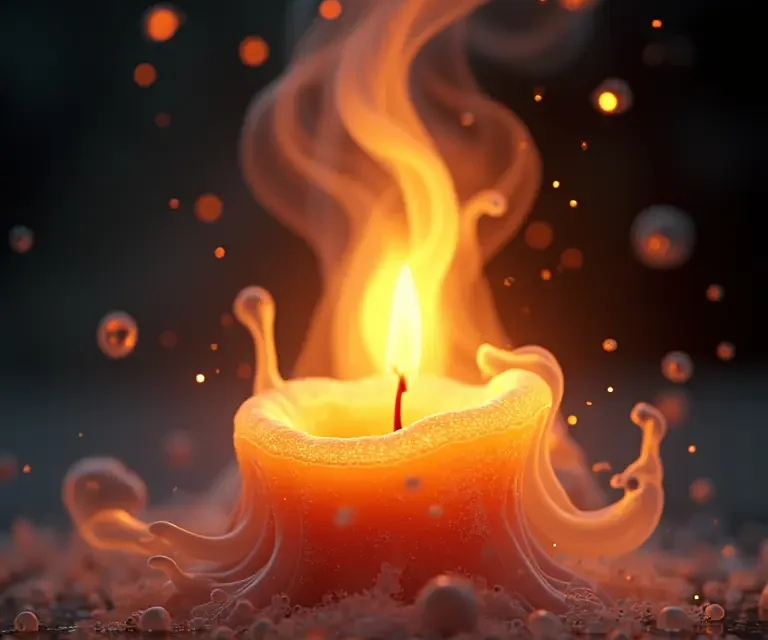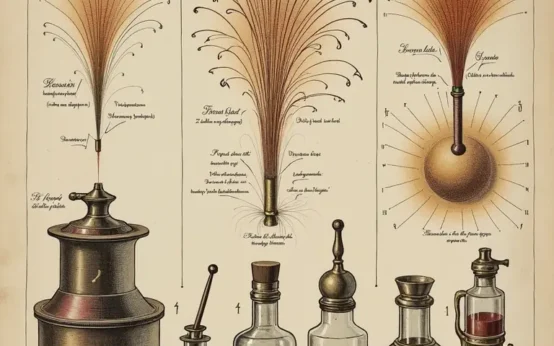For millennia, the flickering flame of a candle has captivated humanity. Beyond its practical use for illumination, it’s been a symbol of hope, remembrance, and even romance. But a candle flame isn’t just a pretty sight; it’s a remarkably complex interplay of physics, chemistry, and fluid dynamics. What’s truly surprising is how consistent these dynamics are, regardless of the candle’s size, shape, or even the wax it’s made from. This article will delve into the history of understanding candle flames, explore the science behind their behavior, and illuminate the surprisingly consistent principles that govern them.
A History Illuminated: From Ancient Observations to Modern Science
Humans have used candles for thousands of years. Early candles, dating back to ancient Egypt and Rome around 3000 BCE, weren’t made of wax, but rather tallow (animal fat) or beeswax. These early forms were smoky and didn’t produce a very bright light, but they provided a crucial source of illumination. Observations about candles were initially practical – how to make them burn brighter, longer, and cleaner. However, early natural philosophers began to ponder why candles burned at all.
Early theories about combustion were often linked to the concept of “phlogiston,” a hypothetical substance believed to be released during burning. Proposed in the 17th century, this theory suggested that combustible materials contained phlogiston, and burning was the process of releasing it. While ultimately incorrect, the phlogiston theory spurred experimentation and observation.
The true nature of combustion wasn’t understood until the work of Antoine Lavoisier in the late 18th century. Lavoisier demonstrated that burning involves the rapid reaction between a substance with oxygen, a previously unknown gas. This discovery revolutionized chemistry and provided the foundation for understanding candle flame dynamics. Michael Faraday, in his famous Christmas Lectures at the Royal Institution in 1860, conducted beautiful and insightful experiments on candle flames, demonstrating the principles of convection, radiation, and the chemical composition of the flame itself. These lectures, accessible even today, are a testament to the enduring fascination with this simple phenomenon.
The Anatomy of a Flame: Zones and Processes
A seemingly simple candle flame is actually composed of distinct zones, each with its own temperature, chemical processes, and light emission characteristics. Let’s break down these zones, starting from the innermost region and moving outwards:
- The Dark Zone: This is the region immediately surrounding the wick. It contains unburnt wax vapor. There isn’t enough oxygen here for combustion to occur, hence the darkness.
- The Luminous Zone: This is the brightest part of the flame, the familiar yellow glow we associate with candles. Here, the wax vapor undergoes incomplete combustion. This incomplete combustion produces tiny particles of carbon (soot) that are heated to incandescence – they glow due to their high temperature.
- The Blue Zone: Located at the outer edge of the flame, this zone represents the region of complete combustion. Here, sufficient oxygen is available to fully oxidize the wax vapor, producing carbon dioxide and water vapor. The blue color comes from chemiluminescence – the emission of light due to a chemical reaction.
- The Invisible Flame: Beyond the blue zone, there’s an area where combustion continues, but the temperature is lower, and the light emission is minimal, making it practically invisible.
The flame isn’t static; it’s a dynamic system driven by convection. The heat from the burning wax vapor causes the surrounding air to rise, creating an upward flow. This convection current brings fresh oxygen to the flame, sustaining the combustion process. The shape of the flame is also influenced by these currents and the surrounding air.
Wax, Wick, and the Fuel Supply
The candle’s fuel source, the wax, plays a crucial role. Different types of wax (paraffin, beeswax, soy wax, etc.) have different melting points, boiling points, and combustion characteristics. However, regardless of the wax type, the process is fundamentally the same. The heat from the flame melts the solid wax near the wick. This liquid wax is then drawn up the wick through capillary action. The wick acts like a sponge, pulling the liquid wax upwards against gravity.
The heat from the flame then vaporizes the liquid wax at the tip of the wick. This wax vapor is the actual fuel that burns. The size and material of the wick are critical. A wick that’s too small won’t deliver enough fuel, resulting in a small flame. A wick that’s too large will deliver too much fuel, leading to a large, smoky flame. The structure of the wick itself is also important; braided wicks are often used to help maintain a consistent fuel supply.
Fluid Dynamics in Action: The Dance of Air and Flame
The behavior of a candle flame is heavily influenced by fluid dynamics – the study of how fluids (liquids and gases) move. The convection currents we mentioned earlier are a prime example. But there’s more to it than just rising hot air. The flame is also affected by disturbances in the surrounding air. A draft, for example, can cause the flame to flicker and bend, as the convection currents are disrupted.
The shape of the flame is also a result of the interplay between buoyancy (the upward force exerted on the hot gases) and viscosity (the resistance of the air to flow). The flame tends to elongate as the hot gases rise, but the viscosity of the air prevents it from becoming infinitely long.
To visualize these concepts, consider this helpful resource:
The Chemistry of Combustion: A Detailed Look
At its core, candle burning is a chemical reaction. The primary fuel is a hydrocarbon – a molecule composed of hydrogen and carbon atoms. For example, paraffin wax is primarily composed of alkanes, a type of hydrocarbon. The combustion reaction can be summarized as follows:
Hydrocarbon + Oxygen → Carbon Dioxide + Water + Heat + Light
The exact chemical reactions are more complex, involving a series of intermediate steps and free radicals. The heat generated by the reaction sustains the process, creating a self-perpetuating cycle. The amount of oxygen available significantly impacts the completeness of combustion. Sufficient oxygen leads to complete combustion, producing primarily carbon dioxide and water. Insufficient oxygen results in incomplete combustion, producing carbon monoxide, soot, and other byproducts.
Consistency in Chaos: Why Flames Behave Predictably
Despite the complex interplay of factors involved, candle flames exhibit a remarkable degree of consistency. This consistency stems from the fundamental laws of physics and chemistry governing the combustion process. The rate of fuel supply, the availability of oxygen, and the heat transfer mechanisms all work together to create a stable flame. While individual flames may flicker and dance, the overall characteristics – temperature distribution, flame height, and combustion products – remain relatively constant.
This predictability has been exploited in various applications, from scientific experiments to industrial processes. For example, candle flames have been used as a source of heat in calorimetry (measuring heat transfer) and as a test flame for evaluating the flammability of materials.
Beyond the Candle: Connections to Other Consistent Systems
The surprisingly consistent behavior of candle flames isn’t an isolated phenomenon. We see similar principles at play in many other natural and engineered systems. Consider the consistent logic found in seemingly complex devices like antique puzzle boxes, where intricate mechanisms are governed by simple physical principles. Or the mathematical relationships that underpin musical instrument tuning, where harmonious sounds arise from precise ratios and frequencies. Even in seemingly subjective areas like Victorian mourning jewelry, consistent symbolism reveals underlying cultural patterns.
The patterns within traditional storytelling and the biochemical reactions that power firefly bioluminescence also demonstrate how underlying principles create consistent outcomes despite apparent complexity.
Conclusion: A Small Flame, a Vast Science
The humble candle flame is far more than just a source of light. It’s a miniature laboratory where fundamental scientific principles come to life. From the history of its understanding to the intricacies of its combustion process, the study of candle flames offers a fascinating glimpse into the world of physics, chemistry, and fluid dynamics. And the surprising consistency of its behavior reminds us that even in a chaotic world, order and predictability can be found if we take the time to look closely. The next time you light a candle, take a moment to appreciate the elegant science unfolding before your eyes.


 The Curious Mechanics of Automaton Birds: A History of Feathered Clockwork
The Curious Mechanics of Automaton Birds: A History of Feathered Clockwork  The Curious Mechanics of Celestial Globes: Mapping the Heavens in Miniature
The Curious Mechanics of Celestial Globes: Mapping the Heavens in Miniature  The Surprisingly Consistent Science of Historical Weather Vanes – Art, Meteorology & Directional Lore
The Surprisingly Consistent Science of Historical Weather Vanes – Art, Meteorology & Directional Lore  The Unexpectedly Consistent Science of Early Firework Composition: Alchemy, Aesthetics & Aerial Displays
The Unexpectedly Consistent Science of Early Firework Composition: Alchemy, Aesthetics & Aerial Displays  The Surprisingly Consistent Logic of Traditional Herbal Remedies: Beyond Folklore, a History of Observation
The Surprisingly Consistent Logic of Traditional Herbal Remedies: Beyond Folklore, a History of Observation  The Surprisingly Consistent Science of Early Map Projections: Distorting the World to Understand It
The Surprisingly Consistent Science of Early Map Projections: Distorting the World to Understand It